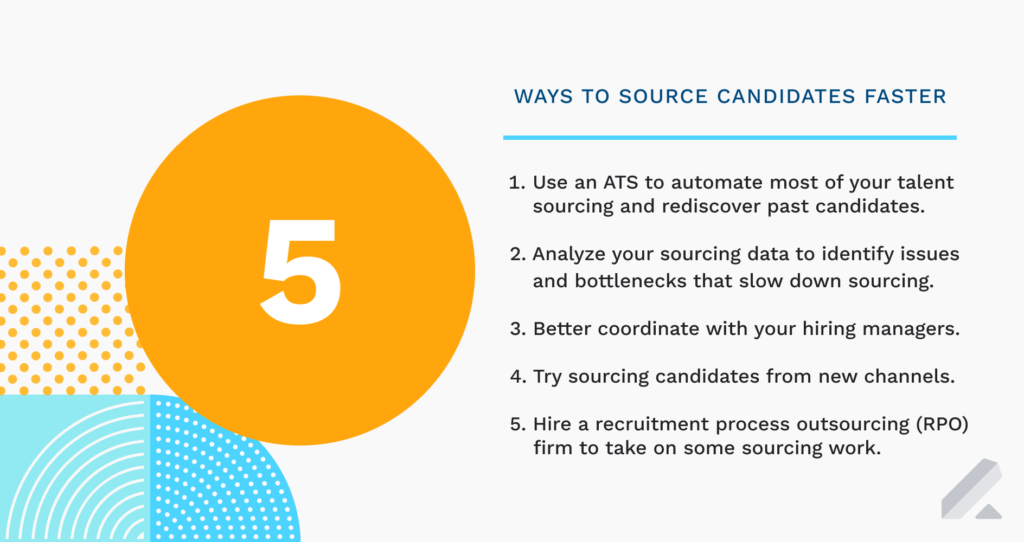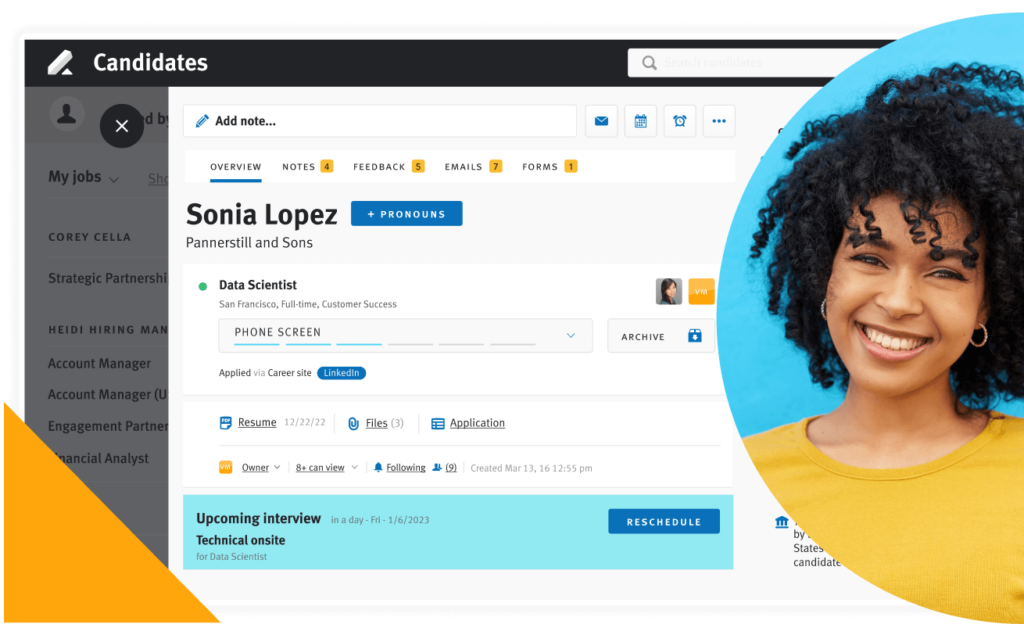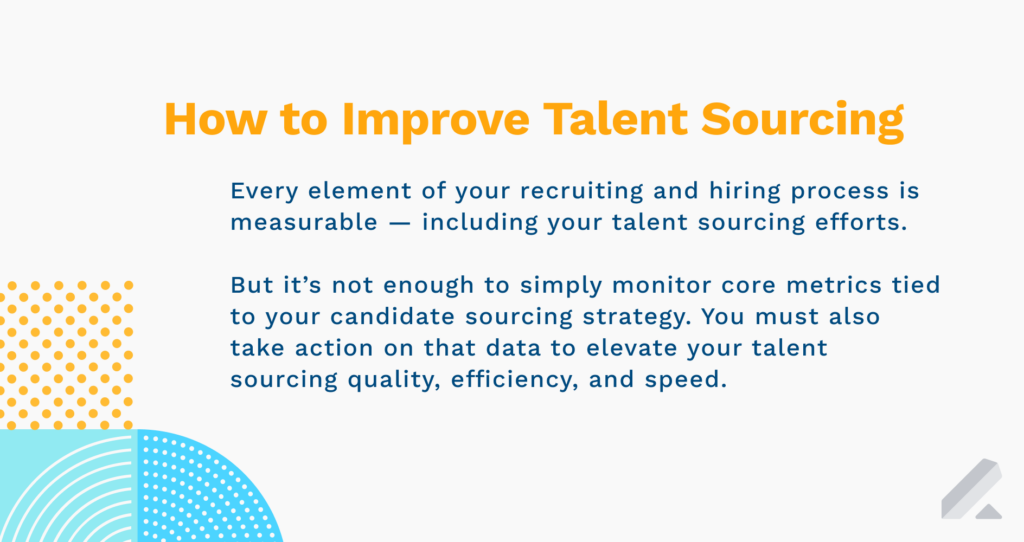More than half of all recruiters spend six hours sourcing candidates each week, according to Indeed, while 22% spend more than 11 hours weekly on this hiring process step.
With sourcing taking between one-quarter to nearly one-third of the recruiting process, decreasing the time spent finding qualified candidates for open positions is essential for speeding time to hire.
How to speed up and streamline your candidate sourcing: 5 hiring process steps that can help
Recruiters automate hiring activities, including reviewing resumes and cover letters and conducting reference checks. Why not do the same with sourcing?
Learn how these hiring process steps can accelerate your sourcing strategy.

1) Use an applicant tracking system (ATS)
Manual sourcing is time intensive. It requires constant attention by your talent team and prevents your recruiters from focusing on other important activities.
That is where an applicant tracking system with candidate relationship management (CRM) and recruiting automation can help. This recruiting technology offers candidate engagement features that help recruiters proactively connect with passive candidates.
With LeverTRM, you can schedule personalized nurture messages to individual candidates and groups of candidates. The first email in your nurture campaigns are typically sourcing emails to gauge the interest of potential candidates.
The more you test different candidate nurture approaches, the better you improve response rates. That includes the initial sourcing outreach.
With Lever recruiting technology for small and scaling companies, you can also enhance your recruitment marketing. LeverTRM also enables businesses to:
- Build a white-label career page featuring your employer brand so you can showcase your company culture and diversity, equity, and inclusion efforts
- Write and format job descriptions that stand out to potential applicants
- Publish job postings with application forms that don’t require a login to submit
The built-in Chrome extension also pulls LinkedIn profile data for passive candidates into LeverTRM. This saves you from having to add candidate details manually and enables faster candidate evaluation.

2) Analyze your talent sourcing data
Data-driven recruiting is essential to hiring success. Analytics tied to your talent acquisition process, including candidate sourcing, are critical to making smarter recruitment and selection decisions.
Within Visual Insights, the talent analytics tool within LeverTRM, you can see:
- How long it takes passive candidates to reply to your initial sourcing outreach
- The distribution of candidates sourced from different channels, including employee referrals, internal candidates, applicants, job boards, and universities
- Which stage of the interview process sourced candidates are in
- How many sourced candidates were hired and how long hiring cycles take
This candidate sourcing and engagement data can inform channels that lead to the most receptive candidates. From there, you can double down on your strongest sources.
You can also use Visual Insights to learn if candidate nurtures should be adjusted to boost sourcing conversions.
Here’s a common scenario. You have a one-email campaign for a group of candidates who would fit the role well. You notice your reply rates are low. Adding a second or third email to your campaign could boost engagement.

3) Better coordinate with hiring managers
Your TA team may struggle to source good-fit talent for open roles because the job criteria from hiring managers isn’t clear or reasonable.
Let’s say a hiring manager wants a new hire to have a specific certification or years of experience. If the job is too junior or the salary offered is below market, you may find it hard to entice candidates with the preferred expertise to apply for the role.
You can avoid this issue by communicating often with hiring managers.
Regular discussions among your talent leader, recruiters, and hiring managers can prevent tension from arising. They can also ensure your recruiters are set up for sourcing success by aligning on job descriptions and candidate preferences.
“Successful recruitment depends on a positive experience for recruiters, which includes solid collaboration with hiring managers and other stakeholders, optimized work processes, and investments in technology to elevate recruiters from ‘order takers’ to talent advisors,” SHRM Talent Acquisition Editor Roy Maurer recently wrote.
With everyone aligned, recruiters can move forward with confidence to find and engage qualified candidates whose skills align with open roles.

4) Test new candidate sourcing channels
Sticking with proven sources that help you source top talent and hire high performers makes sense.
However, if your talent team spends weeks instead of days to find enough qualified candidates to present to hiring managers, consider trying new sources.
LeverTRM connects with 40-plus job boards and aggregators and allows you to universally publish listings.
That means you can post free listings and paid ads in several locations in minutes, not hours, when you integrate with these platforms. And posting to new job boards and aggregators often leads to a higher quantity and quality of candidates.
You can also create candidate profiles for existing employees, secure employee referrals, and rediscover previous candidates. Using these channels can save your recruiters hours each week, since they won’t have to source as many external candidates to evaluate for open roles.
Bonus tip: If you don’t have enough diverse candidates in your talent pool, exploring other sourcing avenues where diverse job seekers look for new roles is ideal.

5) Consider internal candidates
Sourcing external talent is critical to your recruitment process. But don’t forget about internal candidates. Evaluating existing employees for open roles can help you fill them faster.
The 2023 Employ Recruiter Nation report found internal hires are the second-most-valuable source for employers, trailing only job boards. In addition to being a trusted source, LinkedIn research found employees stay 41% longer at companies with internal mobility programs than those without them.
Lever recruiting technology enables your talent team to execute an internal hiring approach:
- You can build candidate profiles in LeverTRM for employees who express interest in career mobility or whose managers recommend them for advancement.
- Integrating your HRIS with your ATS can import employee performance data and other details provided by managers.
- From here, you can evaluate employee details from one location, learn which ones may be strong fits for open roles, and recommend options to hiring managers.
And all this can be done before exploring external candidates.
A bonus of this sourcing approach is faster onboarding. Internal hires can often transition into new roles more seamlessly than external hires, given their familiarity with the business.
Some training may be required for employees, but HR won’t need to conduct reference or background checks for them. Instead, employees can hit the ground running on their start dates, and managers can have key roles filled quickly. And your TA team won’t need to source and engage outside candidates.
This is a win-win-win for your talent team, managers, and employees.
Tackle the first of these hiring process steps by learning all about Lever recruiting technology for small and scaling companies. Schedule a LeverTRM demo for more information.



